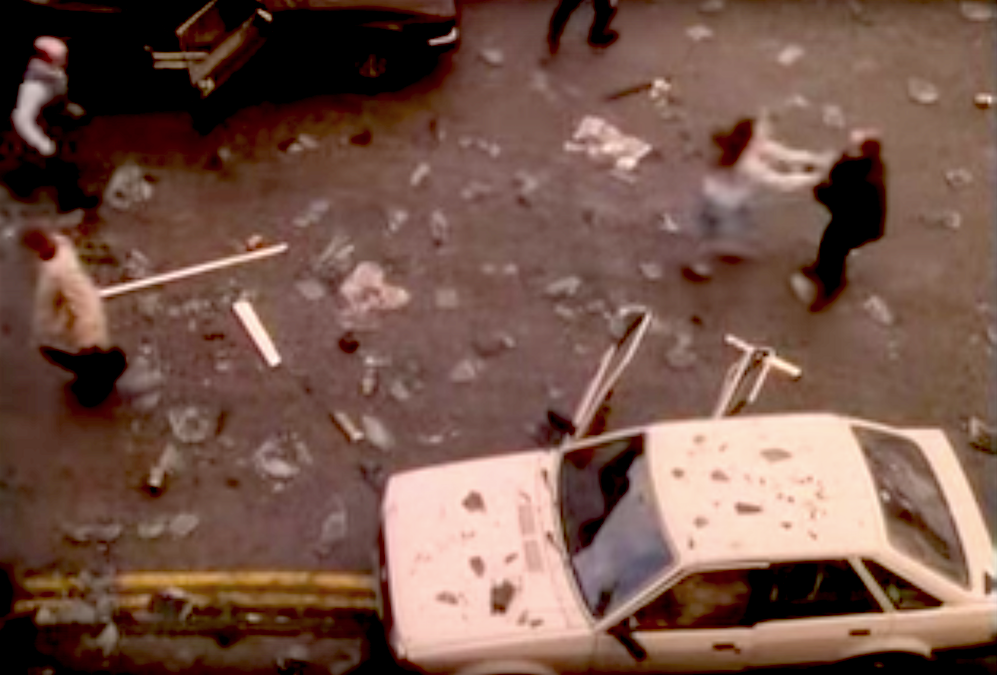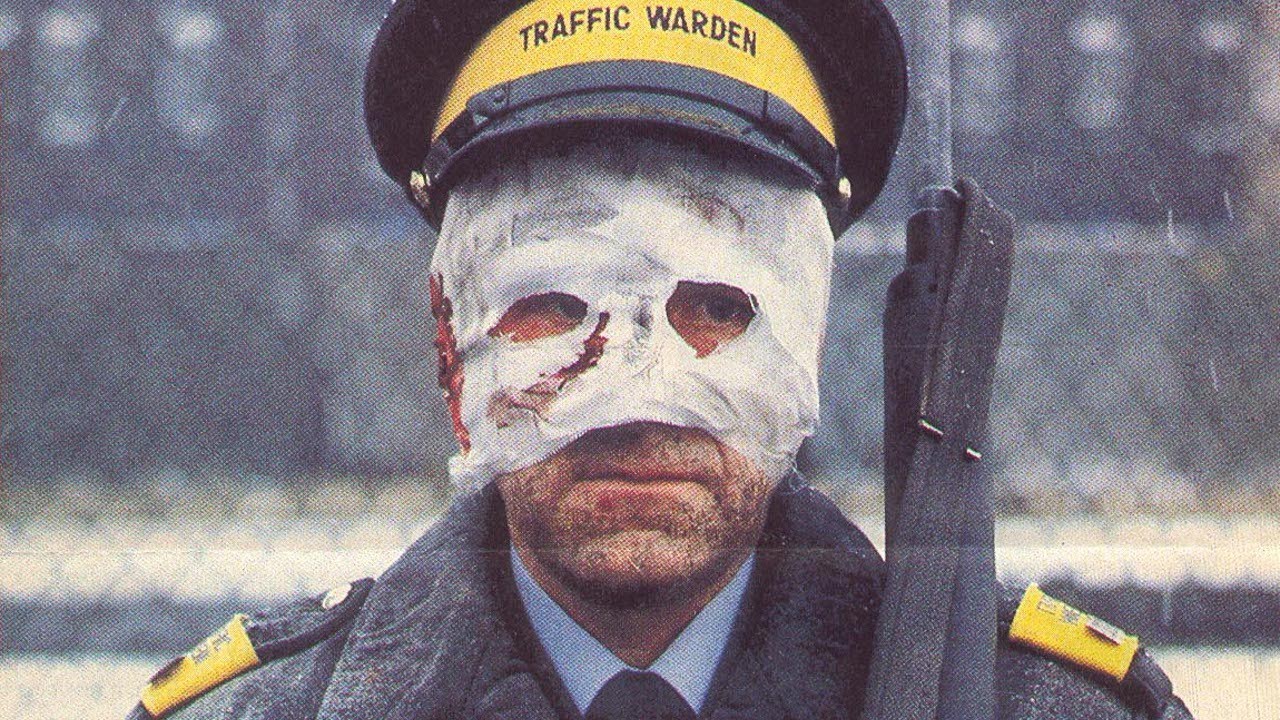The vision of nuclear holocaust in Threads (1984) remains visceral and urgent.
The audience at the 1984 press screening of Barry Hines and Mick Jackson’s BBC TV film Threads apparently walked out in numbed silence. One of them, the novelist Russell Hoban, concluded in The Listener,
This is not a film to be reviewed as a film; its art is that it cancels all aesthetic distance between our unthinking and the unthinkable: here is the death of our life and the birth of a new life for our children, a life … of slow death by radiation sickness and plagues and starvation and quick death by violence.
Threads is a virtually faultless film, but as Hoban suggests, its unrelenting bleakness makes it all but impossible to recommend to someone one likes. That said, it has recently won a “Ten Films That Shook Our World” poll, and tonight, April 10, it’s showing at the Barbican Centre, in London. Spoiler alerts are irrelevant; the movie will spoil your day however you see it. In its harrowing vision of Britain after a nuclear war, pretty much everyone dies eventually, while rats, maggots, and the class system endure. As vividly as it defines the experience of living through the Cold War, we no longer have the luxury of viewing it as a historical document: in January 2017, the Bulletin of Atomic Scientists declared us closer to doomsday than we’ve been since the early eighties.
It’s unsurprising that Hoban admired Threads. Four years earlier, he’d published Riddley Walker, a novel with a similar imagination of how a nuclear war might be historically reflected in language. The book’s pidgin English vocabulary slowly discloses what has happened to it; as readers learns how to translate it back into contemporary English, they catch glimpses of an apocalyptic fall involving a “Belnot Phist” (a Nobel Prize–winning physicist) and the splitting of the “Addam”—or the “lil shynyng man”—turning the world to wilderness. There’s a shock in realizing that this is a technological future, not a primitive past.
Riddley Walker is set around a ruined Canterbury Cathedral in Kent, England. So is another important precursor to Threads, Peter Watkins’s 1965 film, The War Game. Where Hoban stretched language to fit the inconceivability of a world after a nuclear war, Watkins tested the boundaries of the documentary film by folding in fictional, dramatized insertions. Official government advice and statistics on blast radiuses and fallout are counterpointed with interviews by actors playing authority figures and victims; faux news footage describes an incident in China spreading to Berlin, and from there to thermonuclear war. Traumatized policemen mercy kill hopeless casualties and execute looters.
The War Game didn’t reach television as planned—the BBC thought the end product “too horrifying for the medium of broadcasting.” But by the eighties, the capabilities of nuclear weapons and moving images had both expanded. Ronald Reagan’s “Star Wars” defense strategy looked to be increasing, not decreasing, the chance of nuclear war, and so the BBC decided to remake The War Game, an effort that led to three programs that aired in September 1984. One of these was Threads, whose unforgiving, clear-eyed style made it an international phenomenon. In the U.S., with an impassioned introduction from the WTBS network owner Ted Turner, it got record prime-time ratings; viewers saw it as a bracing antidote to the more reassuring, sanitized vision of nuclear winter presented in Hollywood films like The Day After (1983).
Mick Jackson, Threads’s director, had experience in the genre. In 1982, he’d written and produced “A Guide to Armageddon,” an episode of the factual BBC Q.E.D. series about a nuclear bomb exploding above London. Under a patrician-sounding voice-over, couples in fetching period knitwear tried to make bomb shelters work while sides of meat were incinerated and soft-fleshed pumpkins subjected to blizzards of broken glass. It ended asking the same question as The War Game: After a nuclear war, would the living envy the dead?
This is where Threads picks up, taking the same meticulously researched documentary framework and developing the narrative, dramatic elements. The original idea was to create—and then shatter—a sense of the ordinary by using the cast of the TV soap opera Coronation Street, but Jackson ended up favoring relative unknowns. The film follows Jimmy Kemp, who lives with his unemployed father, his textile-worker mother, and two siblings in a council flat in Sheffield. Ruth Beckett lives with her comparatively affluent parents in a large Victorian house. The story opens on Ruth and Jimmy in a car, engaged in some heavy petting; a few months later, Ruth discovers she’s pregnant. They decide to keep the baby and move into a flat together; the bomb drops while Jimmy is at work and Ruth is at her parents’ with morning sickness.
In the council flat, the Kemp children die instantly; Mrs. Kemp is badly burned, and Mr. Kemp lives long enough to become part of an irradiated mob that tries to storm a food depot. He ends up as one of the ten to twenty million unburied corpses in the UK. The Becketts, meanwhile, in their sturdy cellar, are safe from the blast and the worst of the fallout. As the family waits below ground with their cans and buckets, unsure if it’s night or day, Hines brings out the associations with their playwright namesake. Granny Beckett—who was cleared out of the hospital to make space for casualties shortly before the bomb fell—dies, and they drag her body up the stairs, as per government Protect and Survive advice. Ruth runs away looking for Jimmy, and mother and father soon have their heads staved in by looters. Ruth searches for Jimmy in a hospital without electricity, water, or any supplies, where the doctors, the voice-over tells us, can do little more than the average survivor. One of them is stuffing a rag into an unanesthetized man’s mouth and sawing through a limb.
Ruth joins the exodus of refugees from Sheffield and gives birth alone in a howling blizzard as a chained guard dog barks at her. (The American broadcast removed the shots of the new mother having to bite through the umbilical cord.) Then we get a reprise of the end of The War Game, and a sudden realization of why the date has been so regularly rattled up on the screen, telex-style since: it’s been nine months since that first scene, which makes this a grim nativity. This calendrical template also shows how profoundly natural and human rhythms have been disrupted: the population has plunged “to medieval levels,” and Ruth and her daughter, Jane, are forced to till barren fields, hooded against the carcinogenic, cataract-inducing sunlight. When Ruth dies, wizened and milky-eyed, thirteen years after the war, Jane emotionlessly takes her spoon and hairbrush, leaving a book of foreign birds she’d kept as a memento of Jimmy. Later, Jane herself gives birth, and we end with a shot of her mouth opening into a scream as she’s shown her baby.
Up till the moment of childbirth, Jane is, miraculously, fairly undamaged in physical terms. What’s broken is the living thread of language, and any culture around it. Her last words to her mother are “Ruth. Up. Work. Ruth,” and when she tries to get help as she gives birth, all she can say is “Babby n’comin.” When she fights with the father of her child over a rabbit earlier on, they use the Elizabethan-sounding word coney. Perhaps the language hasn’t had time to rebuild itself to the level of Riddley Walker; in one scene, in an orphanage, Ruth and other children look blankly at a TV powered by a generator while they unpick the threads of blankets. The show is an eighties educational program called Words and Pictures, but neither of these things carry meaning now—nor even TV itself.
*
Barry Hines, who wrote the screenplay, died in March 2016. He’s still known best for his novel A Kestrel for a Knave (made into the film Kes by Ken Loach in 1969), in which the misery of a boy’s life in the industrial north of England is briefly lifted by an encounter with nature, but this summer, an invaluable book by Sue Vice and David Forrest will explore the full range of his achievement. The moment the bomb drops might mark a break in Threads, Vice and Forrest point out—it switches genre to something bleaker, less fantastical, than zombie horror—but in Hines’s work, it marks an intensification of themes. For a decade, he’d shown working people being failed by institutions—schools, mines, country estates, professional sport, state provisions for unemployment, the army, the police, marriage. Vice and Forrest’s broader view also demonstrates that when he gives Jane her broken language, Hines is thinking not just as a self-reflexive writer, but as a former school teacher.
At Hines’s archive in Sheffield, the first drafts of Threads are comparatively rosy: civil society basically survives in an extremely authoritarian form. This version aligns more readily with the critic Sean O’Sullivan’s reading of the play: as an indictment not just of Reagan-Thatcher defense programs but of their economic policies, which by then had already devastated the North of England. In this view, the film anticipates Thatcher’s notorious 1987 pronouncement that “there is no such thing as society.”
The final version of Threads takes this to an extreme that allowed Russell Hoban to read it without reference to these politics. His review recalls a passage from Riddley Walker that asks what it is that stares through the eyeholes of human beings: is there something in us that loves the idea of annihilation? Threads has aged well as a statement—if anything can be truly, nondenominationally called evil, it is the nuclear weapon. In 2017, to be sure, we have a different perspective on the scene that features a trade unionist who proves his patriotism at an antiwar protest by proclaiming his opposition to the EU. We watch the ecological crisis Ruth endures with a knowledge of other possible causes. And we recognize, acutely and uncomfortably, the fear and hatred with which she’s treated as a refugee. The specifics of Cold War geopolitics have changed, of course, but Threads’s second half, with its glimpse of the erasure of history, stands as a reminder of what little difference any international doctrine makes after a certain point.
Tom Overton is writing John Berger’s biography; he edited Portraits: John Berger on Artists and Landscapes: John Berger on Art. He’s postdoctoral research fellow on the archives of the Barbican Centre & Guildhall School of Music & Drama, and tweets at @tw_overton.

